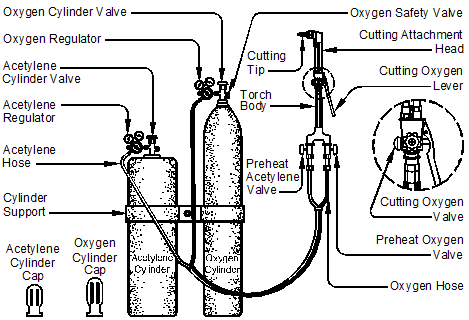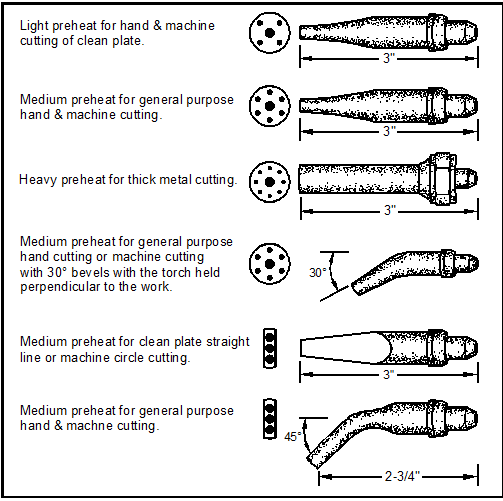- Preface
- Acknowledgements
- Chapter 1: Welding Overview
- Chapter 2: Safety
- Chapter 3: Terms, Joints, & Edge Preparation
- Chapter 4: Tools & Welding Tables
- Chapter 5: Shielded Metal Arc Welding
- Chapter 6: Wire Feed Welding
- Chapter 7: Gas Tungsten Arc Welding
- Chapter 8: Oxyacetylene
- Chapter 9: Controlling Distortion
- Chapter 10: Cutting Processes
- Chapter 11: Brazing & Soldering
- Chapter 12: Common Problems & Solutions
- Chapter 13: Design Tips
- Chapter 14: Fabrication & Repair Tips
- Chapter 15: Tools & Tooling
- Chapter 16: Pipe & Tubing
- Chapter 17: Metallurgy
- Chapter 18: Power Supplies & Electrical Safety
- Chapter 19: Bending & Straightening
- Index
- Credits
Chapter 10
Cutting Processes
Practice is the best of all instruction.
—Aristotle
Section I – Oxyfuel Cutting
Introduction
Oxyfuel cutting is a family of cutting processes which heats the work metal to its kindling point, causing it to burn in a stream of oxygen. Common terms for these processes are flame cutting, oxygen cutting, and burning. The AWS abbreviation for the whole family of oxyfuel cutting processes is OFC and the most prominent member of this family is oxyacetylene cutting, abbreviated OAC. Oxyacetylene is used more for cutting than for welding, but natural gas, propane and propylene are also used for cutting. Oxyfuel cutting is an easy process to use, cuts in all directions, is portable, and it is inexpensive to add to an existing oxyfuel welding outfit. Oxyfuel can cut steel from under 1/32" to over 12' thick. Today, with the decline in the cost of plasma cutting systems, plasma cutting has taken over some jobs once reserved for oxyfuel, but for many steel-cutting applications there still is no faster and more cost-effective process than oxyfuel cutting.
Equipment
A conventional oxyacetylene welding system is easily converted to perform oxyacetylene cutting (OAC) by replacing the welding nozzle on the torch handle with a cutting attachment head as shown in Figure 10-1.
The cutting attachment differs from an oxyacetylene welding torch because it also has a means to deliver a stream of pure oxygen to the cutting point. A cutting oxygen lever opens this pure oxygen stream when the welder depresses it. See Figure 10-2.

Figure 10-1. Oxyacetylene (OAC) cutting outfit.
The advantages of a cutting attachment head over a one-piece cutting torch are that a cutting attachment head is less expensive than a one-piece cutting torch and it is quicker and easier to change back and forth between cutting and welding functions. A one-piece cutting torch, with its greater length, puts more distance between the cutting action and the welder, and can usually handle the greater oxygen flows needed for large jobs. Some cutting torches have cutting attachment heads set at a particular angle for a given task to help relieve operator fatigue. The position of the cutting head, though, is a matter of personal preference and varies by manufacturer.
The torch in Figure 10-2 (left) uses a mixing chamber to bring the oxygen and fuel gases together and is known as a positive-pressure, balanced-pressure or medium-pressure torch. The advantage of the mixing-chamber torch design is that it operates at higher fuel gas pressures and can supply more heat than the venturi design. Positive pressure is the most common torch design today.
The torch in Figure 10-2 (right) uses an injection chamber, or venturi, to draw the fuel gas into the oxygen stream and operates with the low fuel pressures of 6–8 oz/in2. The venturi torch design is needed when natural gas from a gas main is used in place of acetylene for economy or for when acetylene is made on site with a gas generator, which is common in the third world.
Cutting thick steel requires more oxygen than thin steel, so a special oxygen regulator with the capacity of delivering more oxygen volume at higher than welding pressures may be needed to cut steel that is more than one inch thick. Larger diameter hoses are also required. The welding acetylene regulator is fine for cutting. Also, since in cutting there is much higher oxygen consumption and more rapid cylinder depletion than in welding operations, the typical cutting regulator has two-stages to maintain a constant working pressure as the cylinder gas dwindles. Gauges on the high-pressure side of oxygen regulators for cutting have higher pressure calibrations than those of welding regulators. Oxyfuel cutting operations on thick metals can require oxygen pressures as high as 100–150 psi.

Figure 10-2. Oxyacetylene cutting torches. A positive-pressure cutting torch (left) and a venturi design injector cutting torch (right).
Oxyfuel Cutting Tips and Cutting Gases
The cutting tip is the single most important factor determining the quality of a cut. A clean, undamaged cutting tip provides a straight oxygen jet and a safe, stable flame, but because cutting tips are copper they are easily damaged if dropped. For a good cut, the exit end of the jets must be burr-free and perpendicular to the tip face. This is especially true for the oxygen jets. The seats in the base of the tip are also easily damaged either by dropping them or by tightening the tip when there is dirt on the seat. This damage is not usually repairable. In most cases, tips from one torch maker cannot be used in another manufacturer’s torch.
If you have removed the nut that retains the torch tip, and the torch tip is stuck in the torch body, a gentle tap on the back of the torch head with a plastic hammer will usually release the tip.
Because of their proximity to the cutting heat, tips wear out and must eventually be replaced. Also, poor operating practices, rough handling and excessive tip cleaning further shortens the life of a cutting tip. Storing tips in a rack instead of rolling around loose will extend their lives. A wide variety of cutting tips are available to perform different jobs. See Figure 10-3.

Figure 10-3. A selection of special-purpose oxyfuel cutting tips.
Besides acetylene, for economy and availability, natural gas and propylene are also used for preheating in the OFC processes. They are called alternative fuels. Torch tips designed for use with alternative fuels are frequently different because these fuels may be supplied at lower pressures, have different fuel-to-oxygen ratios and different burn-rate characteristics. Methylacetylene-propadiene, known as MAPP gas, was a common and effective alternative gas, but its production was discontinued in North America in 2008 and only less effective substitutes are now available.

